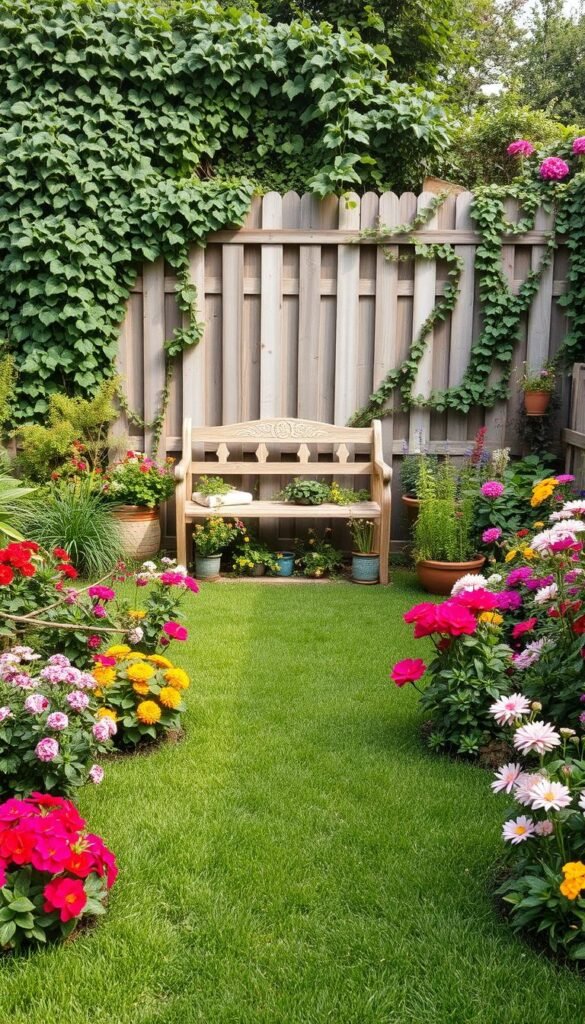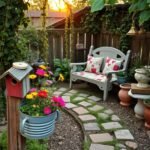Starting your first green space? Even the coziest balcony or patio can bloom into a vibrant retreat with smart planning. This guide reveals practical strategies to help you create a thriving sanctuary that matches your lifestyle—without needing acres of land.
Good design transforms limitations into opportunities. Cool-toned plants like lavender or hydrangeas can make tight areas feel airy, while vertical planters maximize every inch. Trained fruit trees or hanging baskets add charm without clutter—perfect for patios or narrow yards.
You’ll discover how simple tweaks—like repeating plants or using gravel instead of grass—create visual harmony. For year-round color, try multi-season perennials or compact veggies that thrive in small garden design ideas. Even shady corners shine with ferns or hostas.
By blending function and beauty, your outdoor spot becomes more than dirt and leaves. Imagine plucking herbs for dinner or unwinding beside scented blooms. Ready to turn that overlooked space into your personal oasis? Let’s dig in.
Introduction: Embracing Small Garden Possibilities
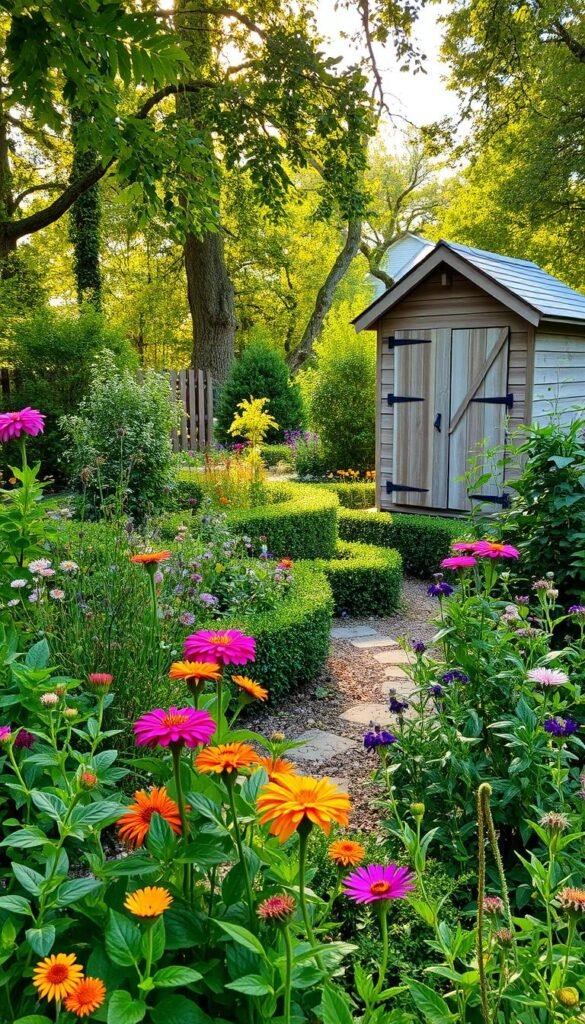
Your cozy corner becomes a canvas when you approach it strategically. Think of it as a puzzle where every inch matters—sunlit patches become herb havens, while shady spots host lush foliage. The key lies in working with your environment rather than against it.
Map Your Micro-Territory
Grab a notebook and track sunlight patterns for three days. Morning rays on your west-facing wall? Ideal for rosemary or thyme. That dim corner by the fence? Perfect for spinach or mint. Sketch your space’s dimensions—even irregular shapes hold hidden opportunities.
Define What Thrills You
Ask: “Do I want snipping herbs for meals or blooms for bouquets?” Focus fuels success. Start with three priority plants, then expand. A windowsill salad garden or cascading petunias in hanging pots offer quick wins that build momentum.
Remember, growth takes time. Celebrate each sprout and adjust as you learn. Your outdoor space evolves with you—today’s basil plant could inspire tomorrow’s vertical herb wall.
Designing with Limited Space in Mind

Transform tight corners into inviting retreats by mastering smart spatial relationships. Professional landscapers swear by the 50/50 balance rule—half greenery, half hard surfaces. This golden ratio keeps your area functional without feeling like a jungle or concrete slab.
Clever Layout Tips
Curved pathways trick the eye into seeing depth. Try winding gravel trails between raised beds of lavender and sage. “Break sightlines to create mystery,” suggests landscape designer Mara Hoffman. Use low hedges or trellises to divide zones, making your space feel like multiple rooms.
| Traditional Approach | 50/50 Method | Result |
|---|---|---|
| 70% plants, 30% paving | Balanced greenery and surfaces | No overcrowding |
| Straight borders | Soft curves and angles | Illusion of space |
| Single focal point | Multiple mini-zones | Visual intrigue |
Position seating areas near fragrant herbs like lemon thyme. This way, you’ll enjoy scents while relaxing. Tall planters draw attention upward, freeing precious ground space for movement. Remember: every element should serve two purposes—a bench with storage underneath or edible flowers that beautify salads.
Planning for Vertical Growth
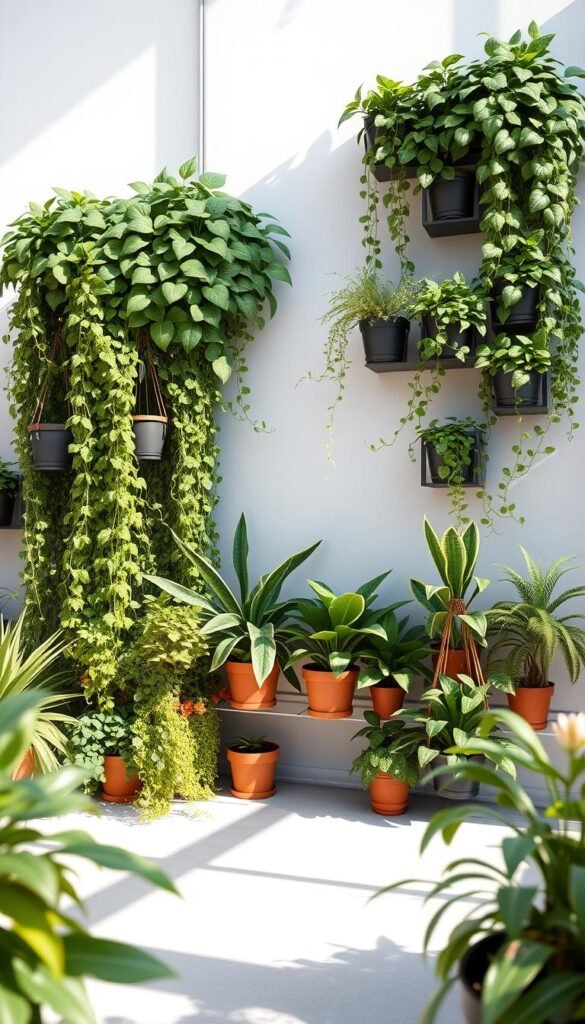
Go vertical to multiply your growing area without expanding your footprint. Walls, fences, and overhead structures become prime real estate when you shift your perspective upward. This approach lets you cultivate more plants while keeping ground space open for seating or pathways.
Using Hanging Baskets and Planters
Hanging containers turn blank surfaces into blooming displays. Lightweight options like plastic or resin work best—try trailing lobelia or cherry tomatoes. Water these more frequently than ground-planted varieties, as they dry faster in breezy spots.
| Sun Exposure | Best Hanging Plants | Water Needs |
|---|---|---|
| Full Sun | Petunias, Strawberries | Daily |
| Partial Shade | Fuchsia, Lettuce | Every 2 Days |
| Full Shade | Begonias, Ivy | Weekly |
Installing DIY Green Walls
Transform any wall into a living tapestry with repurposed materials. Upcycle wooden pallets into strawberry planters or mount vinyl gutters for herbs. Landscape designer Tara Heibel notes: “Fabric pocket systems let you grow 30+ plants in 4 square feet—perfect for patios.”
Ensure proper drainage by adding gravel layers beneath soil. Mix textures for visual impact—pair spiky succulents with flowing sweet potato vines. Your vertical garden will thrive with weekly feeding and rotational watering.
Creating Balance with Planting and Hardscaping
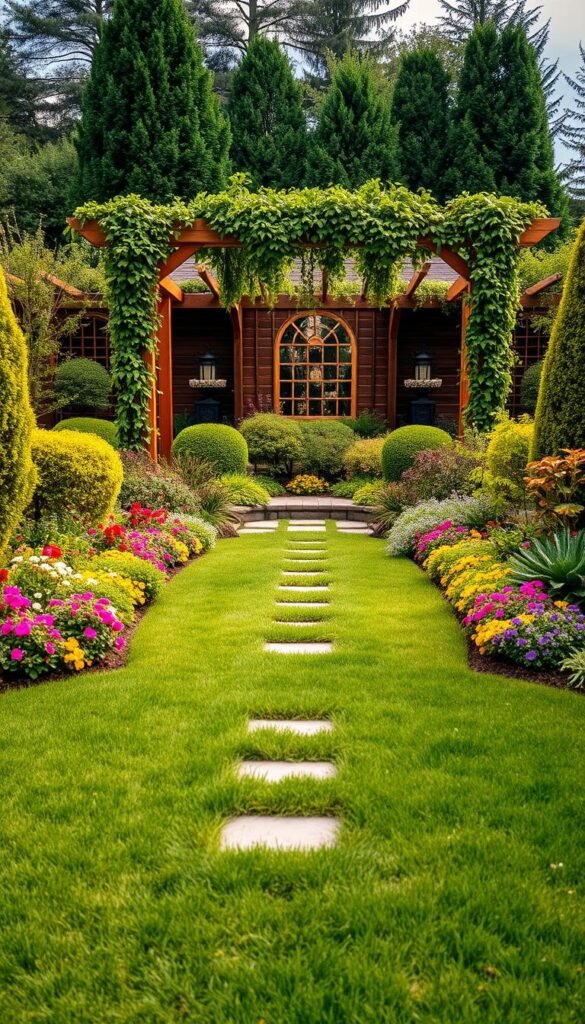
Crafting a harmonious outdoor space starts with balancing living elements and built features. Imagine your patio as a living room where greenery and walkways work together—neither overwhelming the other. This equilibrium keeps your area functional while maintaining natural charm.
The 50/50 Planting and Paving Principle
Professional designers swear by splitting your space evenly between softscapes (plants, grass) and hardscapes (paths, seating). Light-colored materials like pale stone or bleached wood reflect sunlight, making cramped areas feel airy. Dark pavers absorb light, shrinking visual space—save those for large yards.
| Material Type | Light Reflection | Best Uses |
|---|---|---|
| Light Gray Pavers | High | Central pathways |
| Cream Decking | Medium | Seating zones |
| Charcoal Tiles | Low | Accent borders |
Place seating near fragrant herbs like lavender so you enjoy scents while relaxing. Leave room between planting beds for easy watering and pruning. Landscape architect James Corner notes: “Paving patterns can guide movement—circles soften square spaces, while diagonal lines add drama.”
Mix permanent features like stone benches with movable pots. This lets you refresh your garden layout seasonally without major overhauls. Your space stays organized yet adaptable—ready for summer basil or autumn mums.
Utilizing Repetition and Color to Enhance Space
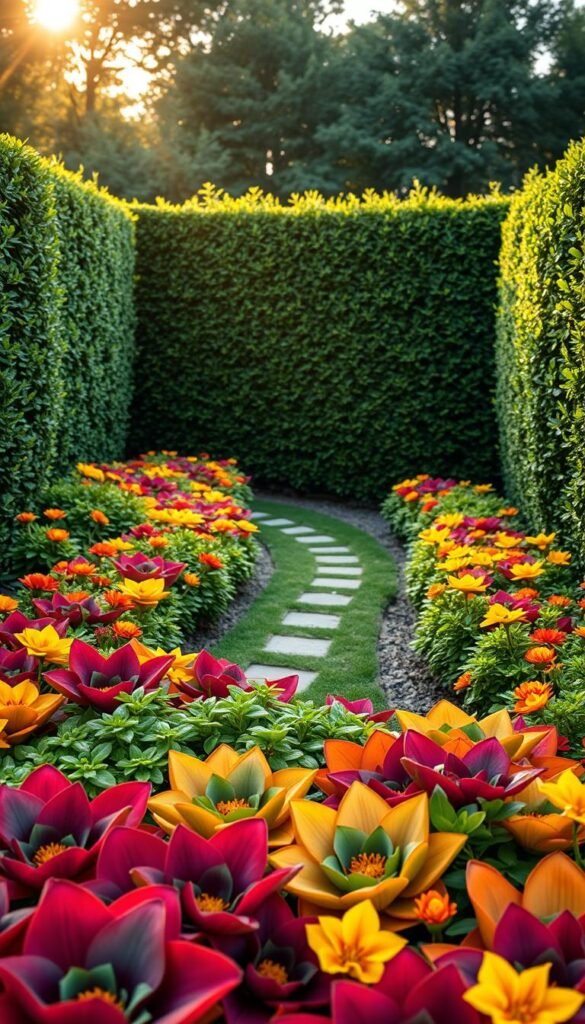
Unlock hidden dimensions in your outdoor area through clever color tricks and pattern play. Cool-toned flowers like lavender or hydrangeas push boundaries visually, making your space feel deeper. Warm shades like marigolds or geraniums bring energy to seating zones—perfect for cozy breakfast nooks.
Repeating elements creates rhythm. Try three matching ceramic pots along a pathway with identical herbs. Landscape designer Emily Henderson notes: “Three repetitions form a pattern—five becomes predictable.” Stick to odd numbers for natural flow.
Limit your palette to three main hues. A blue-purple-white scheme with salvias, lobelia, and daisies looks polished. Contrast textures instead of colors—velvety lamb’s ear beside spiky yucca adds interest without chaos.
Group plants in clusters rather than single specimens. Five pink begonias in a corner outshine scattered blooms. This approach tricks the eye into seeing abundance while maintaining order.
Remember: less variety means bigger impact. Choose two star performers like roses and sage, then repeat them throughout. Your space gains unity while feeling intentionally curated—no random seedlings required.
Choosing the Right Plants for Small Gardens
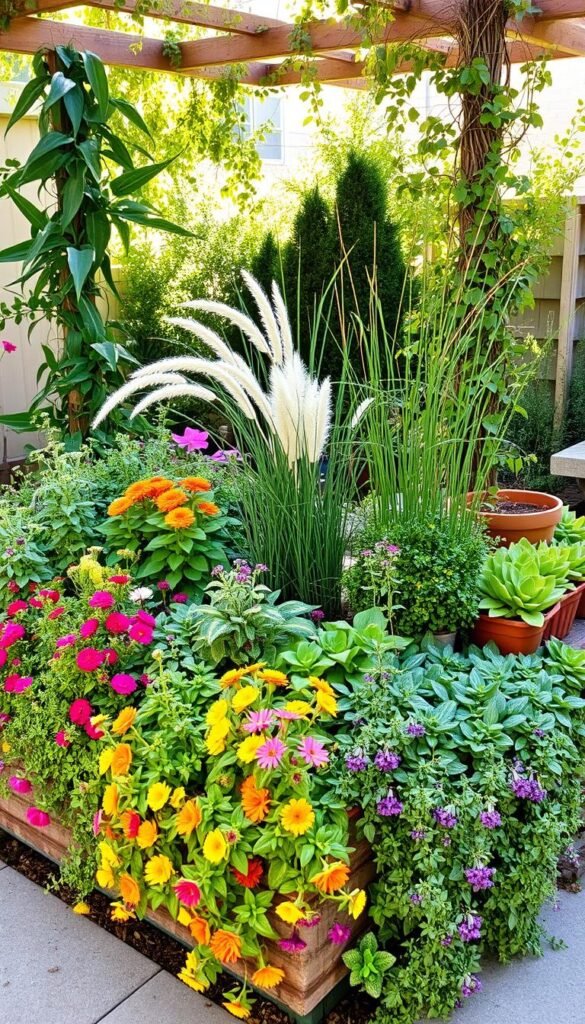
Your plant choices make all the difference when space is limited. Focus on varieties that deliver multiple benefits—color, texture, and function—throughout the growing season. This approach ensures every square inch works hard to delight your senses and serve practical needs.
Long-Lasting Blooms and Useful Herbs
Prioritize perennials that bloom for months rather than weeks. Hardy geraniums thrive in partial shade, while Erysimum ‘Bowles’s Mauve’ offers purple clusters from spring to frost. Landscape designer Lauren Dunec suggests: “Repeat-flowering roses like ‘Sweet Drift’ provide fragrance and color without constant pruning.”
- Thyme: Drought-tolerant ground cover with edible leaves
- Basil: Compact varieties like ‘Spicy Globe’ for containers
- Chives: Ornamental grass-like foliage with edible blooms
Space-Smart Edibles
Dwarf fruit trees like ‘Stella’ cherry thrive in large pots, yielding full-size fruit. Try these compact edibles:
| Vegetable | Days to Harvest | Container Size |
|---|---|---|
| Patio Peppers | 60-70 | 5-gallon |
| Baby Kale | 25-30 | Shallow window box |
| Bush Beans | 50-55 | 12″ pot |
Mix edible flowers like nasturtiums with your veggies—they repel pests while adding color to salads. This dual-purpose strategy maximizes your garden’s productivity and beauty.
Maximizing Outdoor Structures and Features
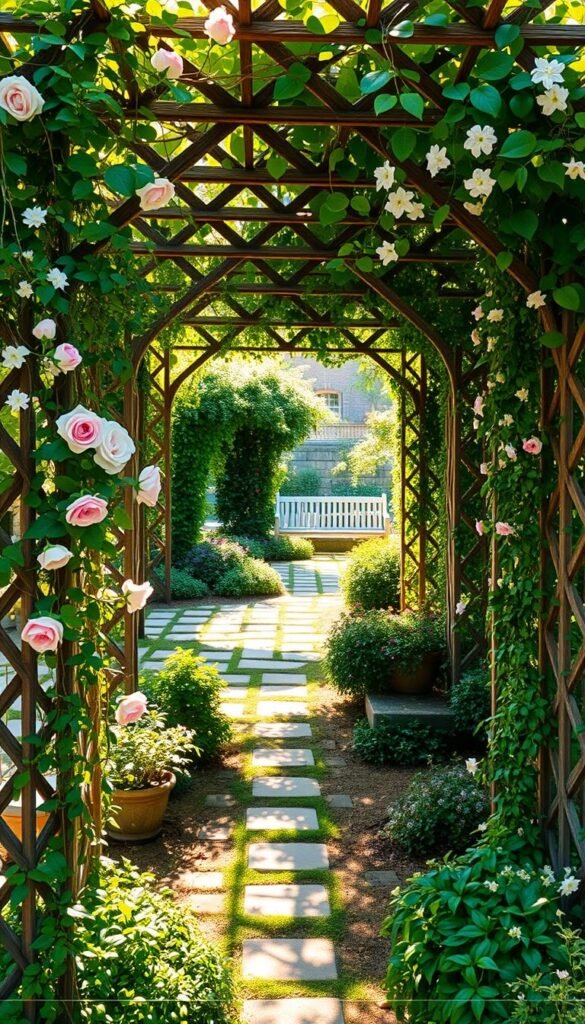
Elevate your outdoor area’s potential by turning functional elements into eye-catching displays. Vertical structures like trellises transform plain walls into living art while boosting your growing capacity. These features work overtime—supporting plants, creating shade, and adding depth to compact spaces.
Incorporating Trellises and Pergolas
Trellises offer instant vertical real estate for climbing veggies and flowers. Build your own using wood slats and chicken wire, or repurpose old fencing panels. Landscape designer Amy Whitney notes: “A simple arch over a pathway creates drama while guiding vine growth upward.”
Position these structures near seating areas to frame views. Pole beans and morning glories thrive on sun-facing supports, while shade-loving ivy softens north-facing fences. The ground beneath becomes prime space for lettuce or spinach—these greens appreciate filtered light from overhead foliage.
For quick impact, install pre-made metal trellises against blank walls. Train passionflower or clematis to weave through the grid. You’ll gain privacy and pollinators while keeping walkways clear. Every inch earns its keep when you think vertically first.
Innovative Small Garden Design Ideas
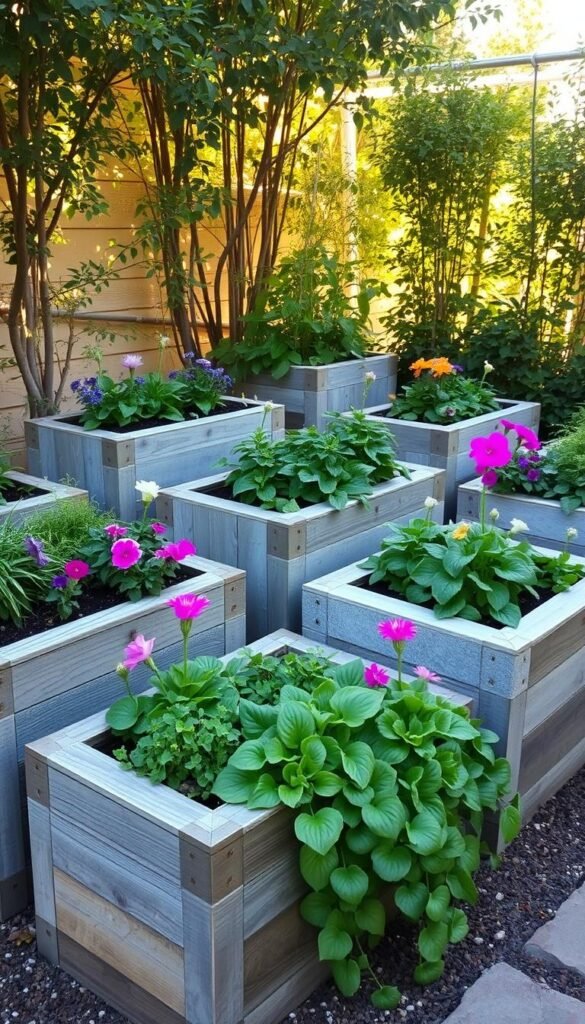
Revolutionize your growing space with clever container strategies that adapt to your lifestyle. Containers and raised beds let you bypass poor soil quality while adding visual structure. These flexible systems work equally well on concrete patios, balconies, or sloped yards.
Elevated Planting Made Simple
Raised garden beds give roots room to breathe while keeping weeds at bay. Build yours using cedar planks or repurposed bricks—height matters more than width. Landscape pro Emma Smith advises: “A 24-inch depth accommodates carrots, while 12 inches suits most herbs.”
| Material | Cost | Lifespan |
|---|---|---|
| Cedar Wood | $$ | 7-10 years |
| Galvanized Steel | $$$ | 15+ years |
| Recycled Plastic | $ | 5-8 years |
Group three large containers near seating areas—plant mint in one, cherry tomatoes in another. This creates a mini edible landscape without crowding walkways. Remember: odd numbers feel more natural than pairs.
Reimagining Traditional Planters
Window boxes aren’t just for sill displays. Mount them horizontally along fence tops for strawberries or vertically as living wall panels. Try these combos:
- Trailing ivy + upright chives
- Colorful pansies + feathery dill
- Compact basil + marigold pesto-guards
Rotate pots seasonally—swap spring tulips for summer peppers, then autumn chrysanthemums. One statement urn with ornamental grasses makes bigger impact than six scattered seedlings. Your space stays fresh without constant replanting.
Mixing Indoor and Outdoor Planting Solutions
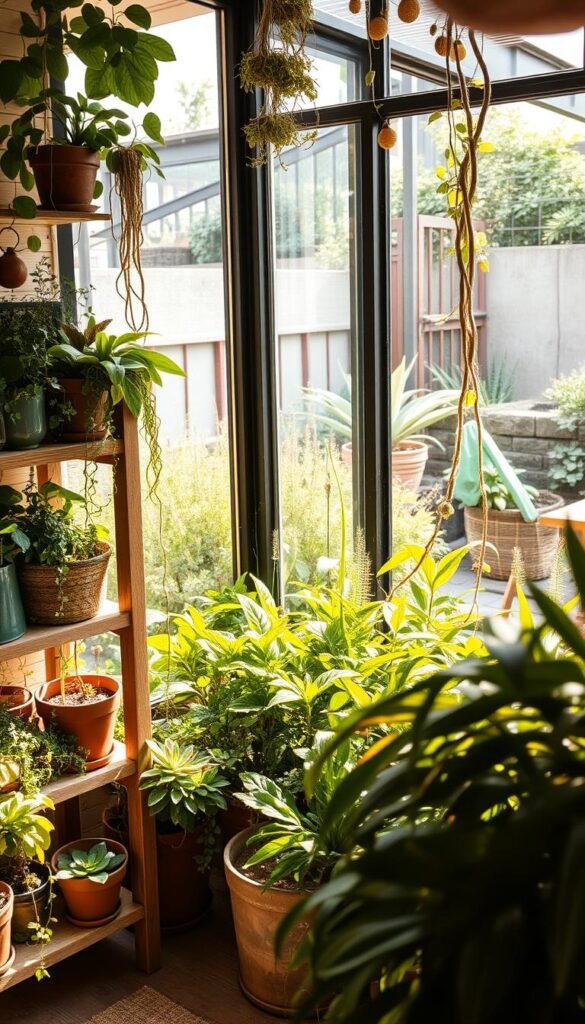
Blur the lines between your living spaces with adaptable greenery that thrives anywhere. Simple rope techniques let you craft hanging displays that work equally well by sunny windows or under covered patios. No ground? No problem. These “plant hammocks” attach to walls or ceilings, freeing up floor space while adding life to overlooked corners.
Master basic knots like the bowline or clove hitch to create adjustable holders. Landscape designer Cara Robbins notes: “Macramé planters allow easy height adjustments—crucial for moving sun-loving herbs closer to light sources.” Use weather-resistant jute for outdoor setups and cotton indoors for a softer look.
Choose plants that adapt to changing environments:
- Spider plants: Thrive in bright rooms or shaded balconies
- Pothos: Tolerate low light indoors, partial sun outside
- Herbs like mint: Transition between kitchen windowsills and summer decks
Rotate specimens seasonally—bring tropical ferns inside before frost, then move them back when temperatures rise. This approach keeps your home feeling fresh while protecting delicate varieties.
| Plant | Indoor Light | Outdoor Light |
|---|---|---|
| Snake Plant | Low | Shade |
| Coleus | Bright indirect | Partial sun |
| English Ivy | Medium | Full shade |
Create visual flow by repeating the same planting containers throughout your room and patio. Three matching ceramic pots with interchangeable herbs or flowers unite spaces seamlessly. Your green companions become mobile decor elements, ready to shift with your needs or the weather.
10 Small Garden Design Ideas and Layouts for First-Time Gardeners
Your outdoor canvas awaits creative solutions that turn limitations into lush possibilities. An arched trellis dripping with jasmine becomes a living sculpture while supporting vertical growth. Raised beds offer better drainage for herbs, and tiered terra-cotta pots create eye-catching displays without hogging your patio.
Got an old wheelbarrow? Drill drainage holes and fill it with trailing petunias—instant mobile color. Repurpose vinyl gutters as strawberry planters along sunny fences. Use bamboo stakes to guide beans upward, freeing ground space for compact veggies like radishes.
Even forgotten corners shine. Stack pavers in your side yard to build a mini rock garden with drought-tolerant sedums. A whiskey barrel pond surrounded by smooth stones attracts pollinators while adding tranquility. Label plants with painted rocks to stay organized and add personality.
These strategies prove that clever design beats square footage every time. Whether you’re growing salad greens or crafting a cozy retreat, your garden becomes what you imagine—one creative choice at a time.

